Comparative Analysis of Communication Strategies: Visy vs RFG
VerifiedAdded on 2023/05/30
|13
|2625
|215
Essay
AI Summary
This essay provides a comparative analysis of communication strategies employed by two Australian businesses: Visy and Retail Food Group (RFG). The report begins with an executive summary and introduction, highlighting the importance of effective communication in business success. It then delves into the factors contributing to Visy's strong performance, including well-defined communication channels, an open-door policy, cultural diversity awareness, clear objectives, training and development programs, employee empowerment, and social media usage. Conversely, the essay examines the causes of RFG's poor communication, such as poor leadership, demoralized employees, fear of uncertainty, lack of diversity, and personal challenges among employees. The report incorporates relevant theories like Hofstede's cultural model and Herzberg's two-factor theory to explain the communication dynamics within the companies. Finally, the essay offers actionable recommendations for RFG to improve its communication, including employee motivation, embracing cultural diversity, and providing training. The conclusion summarizes the key findings and emphasizes the importance of effective communication for business success, as demonstrated by the contrasting examples of Visy and RFG.
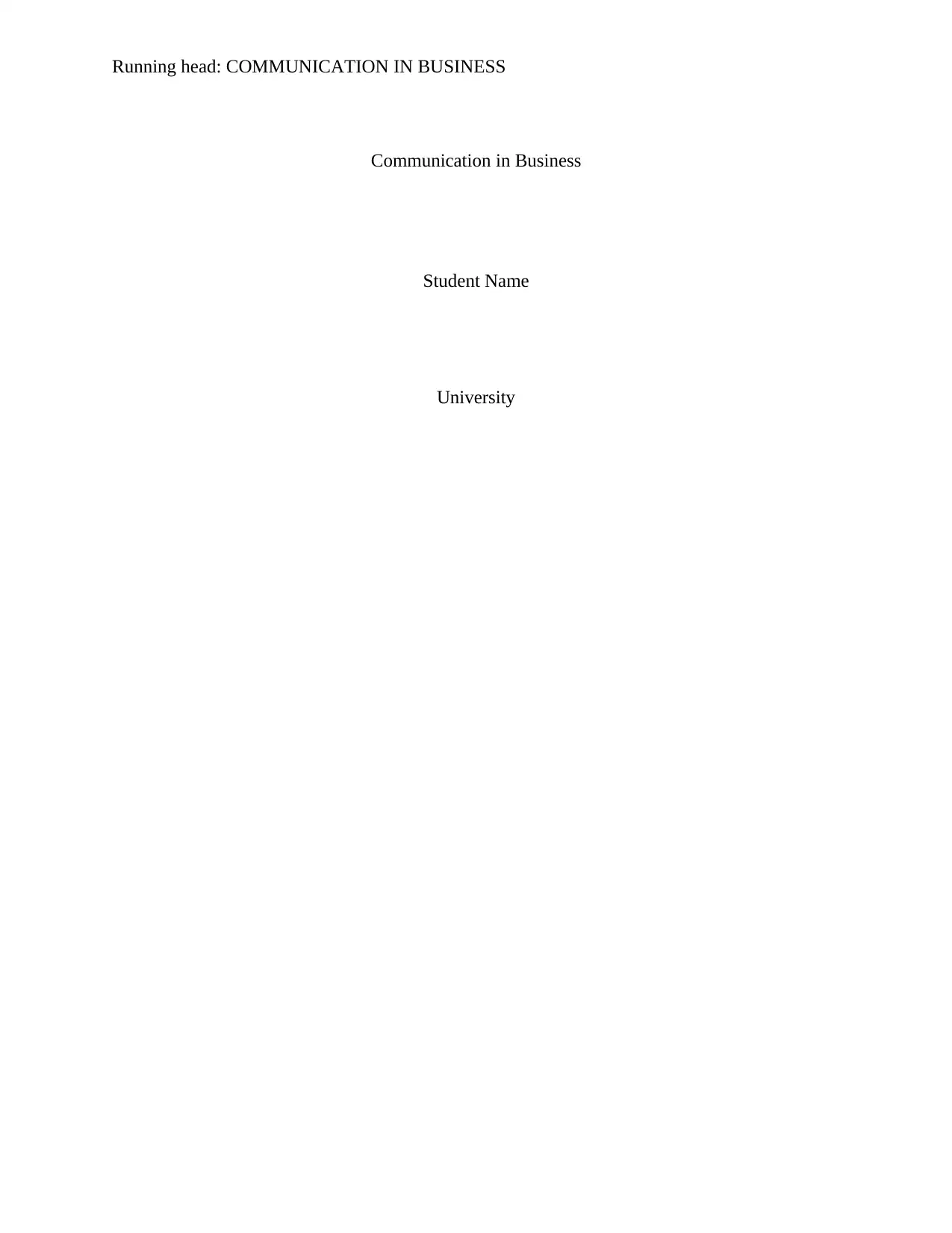
Running head: COMMUNICATION IN BUSINESS
Communication in Business
Student Name
University
Communication in Business
Student Name
University
Paraphrase This Document
Need a fresh take? Get an instant paraphrase of this document with our AI Paraphraser
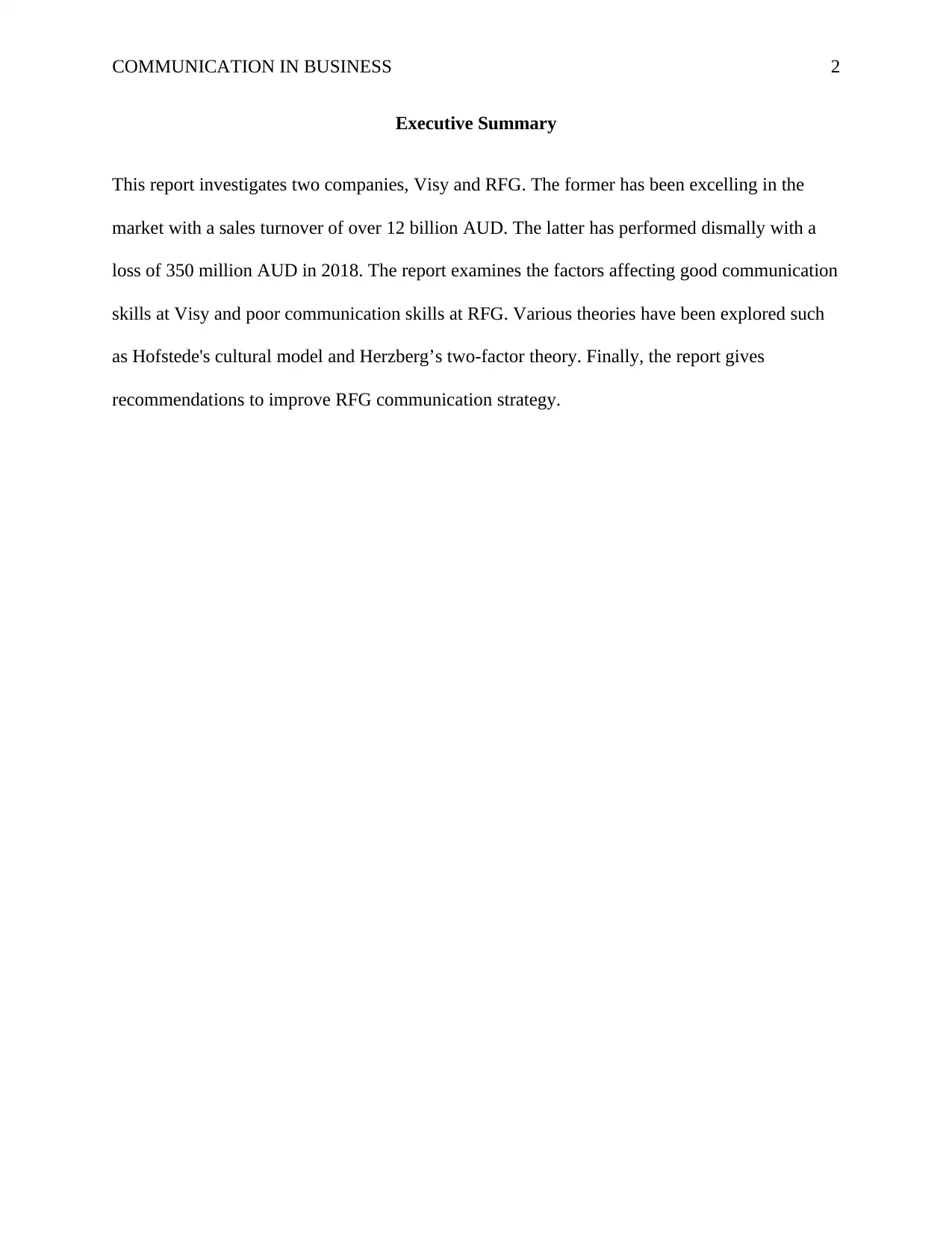
COMMUNICATION IN BUSINESS 2
Executive Summary
This report investigates two companies, Visy and RFG. The former has been excelling in the
market with a sales turnover of over 12 billion AUD. The latter has performed dismally with a
loss of 350 million AUD in 2018. The report examines the factors affecting good communication
skills at Visy and poor communication skills at RFG. Various theories have been explored such
as Hofstede's cultural model and Herzberg’s two-factor theory. Finally, the report gives
recommendations to improve RFG communication strategy.
Executive Summary
This report investigates two companies, Visy and RFG. The former has been excelling in the
market with a sales turnover of over 12 billion AUD. The latter has performed dismally with a
loss of 350 million AUD in 2018. The report examines the factors affecting good communication
skills at Visy and poor communication skills at RFG. Various theories have been explored such
as Hofstede's cultural model and Herzberg’s two-factor theory. Finally, the report gives
recommendations to improve RFG communication strategy.
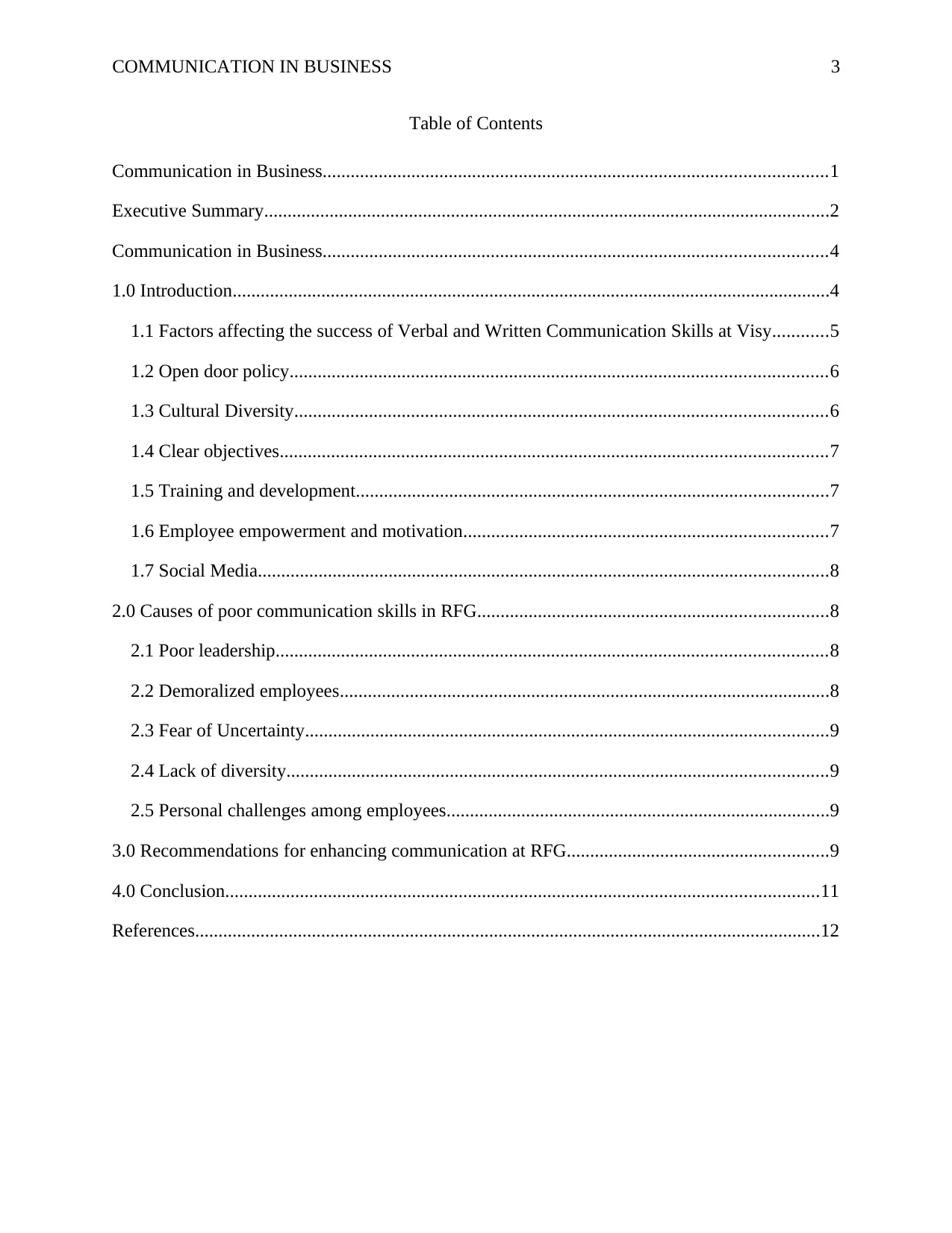
COMMUNICATION IN BUSINESS 3
Table of Contents
Communication in Business............................................................................................................1
Executive Summary.........................................................................................................................2
Communication in Business............................................................................................................4
1.0 Introduction................................................................................................................................4
1.1 Factors affecting the success of Verbal and Written Communication Skills at Visy............5
1.2 Open door policy...................................................................................................................6
1.3 Cultural Diversity..................................................................................................................6
1.4 Clear objectives.....................................................................................................................7
1.5 Training and development.....................................................................................................7
1.6 Employee empowerment and motivation..............................................................................7
1.7 Social Media..........................................................................................................................8
2.0 Causes of poor communication skills in RFG...........................................................................8
2.1 Poor leadership......................................................................................................................8
2.2 Demoralized employees.........................................................................................................8
2.3 Fear of Uncertainty................................................................................................................9
2.4 Lack of diversity....................................................................................................................9
2.5 Personal challenges among employees..................................................................................9
3.0 Recommendations for enhancing communication at RFG........................................................9
4.0 Conclusion...............................................................................................................................11
References......................................................................................................................................12
Table of Contents
Communication in Business............................................................................................................1
Executive Summary.........................................................................................................................2
Communication in Business............................................................................................................4
1.0 Introduction................................................................................................................................4
1.1 Factors affecting the success of Verbal and Written Communication Skills at Visy............5
1.2 Open door policy...................................................................................................................6
1.3 Cultural Diversity..................................................................................................................6
1.4 Clear objectives.....................................................................................................................7
1.5 Training and development.....................................................................................................7
1.6 Employee empowerment and motivation..............................................................................7
1.7 Social Media..........................................................................................................................8
2.0 Causes of poor communication skills in RFG...........................................................................8
2.1 Poor leadership......................................................................................................................8
2.2 Demoralized employees.........................................................................................................8
2.3 Fear of Uncertainty................................................................................................................9
2.4 Lack of diversity....................................................................................................................9
2.5 Personal challenges among employees..................................................................................9
3.0 Recommendations for enhancing communication at RFG........................................................9
4.0 Conclusion...............................................................................................................................11
References......................................................................................................................................12
⊘ This is a preview!⊘
Do you want full access?
Subscribe today to unlock all pages.

Trusted by 1+ million students worldwide
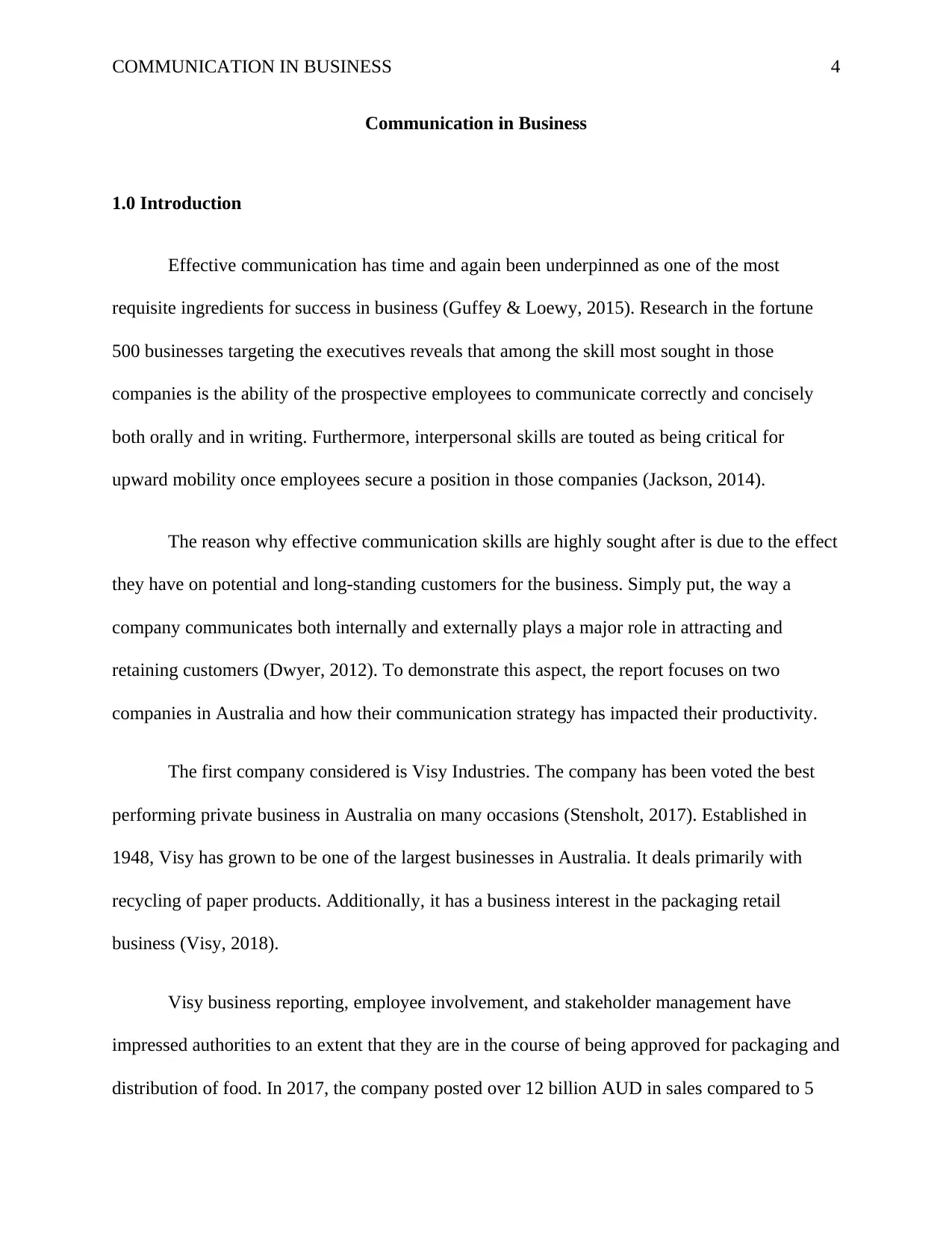
COMMUNICATION IN BUSINESS 4
Communication in Business
1.0 Introduction
Effective communication has time and again been underpinned as one of the most
requisite ingredients for success in business (Guffey & Loewy, 2015). Research in the fortune
500 businesses targeting the executives reveals that among the skill most sought in those
companies is the ability of the prospective employees to communicate correctly and concisely
both orally and in writing. Furthermore, interpersonal skills are touted as being critical for
upward mobility once employees secure a position in those companies (Jackson, 2014).
The reason why effective communication skills are highly sought after is due to the effect
they have on potential and long-standing customers for the business. Simply put, the way a
company communicates both internally and externally plays a major role in attracting and
retaining customers (Dwyer, 2012). To demonstrate this aspect, the report focuses on two
companies in Australia and how their communication strategy has impacted their productivity.
The first company considered is Visy Industries. The company has been voted the best
performing private business in Australia on many occasions (Stensholt, 2017). Established in
1948, Visy has grown to be one of the largest businesses in Australia. It deals primarily with
recycling of paper products. Additionally, it has a business interest in the packaging retail
business (Visy, 2018).
Visy business reporting, employee involvement, and stakeholder management have
impressed authorities to an extent that they are in the course of being approved for packaging and
distribution of food. In 2017, the company posted over 12 billion AUD in sales compared to 5
Communication in Business
1.0 Introduction
Effective communication has time and again been underpinned as one of the most
requisite ingredients for success in business (Guffey & Loewy, 2015). Research in the fortune
500 businesses targeting the executives reveals that among the skill most sought in those
companies is the ability of the prospective employees to communicate correctly and concisely
both orally and in writing. Furthermore, interpersonal skills are touted as being critical for
upward mobility once employees secure a position in those companies (Jackson, 2014).
The reason why effective communication skills are highly sought after is due to the effect
they have on potential and long-standing customers for the business. Simply put, the way a
company communicates both internally and externally plays a major role in attracting and
retaining customers (Dwyer, 2012). To demonstrate this aspect, the report focuses on two
companies in Australia and how their communication strategy has impacted their productivity.
The first company considered is Visy Industries. The company has been voted the best
performing private business in Australia on many occasions (Stensholt, 2017). Established in
1948, Visy has grown to be one of the largest businesses in Australia. It deals primarily with
recycling of paper products. Additionally, it has a business interest in the packaging retail
business (Visy, 2018).
Visy business reporting, employee involvement, and stakeholder management have
impressed authorities to an extent that they are in the course of being approved for packaging and
distribution of food. In 2017, the company posted over 12 billion AUD in sales compared to 5
Paraphrase This Document
Need a fresh take? Get an instant paraphrase of this document with our AI Paraphraser
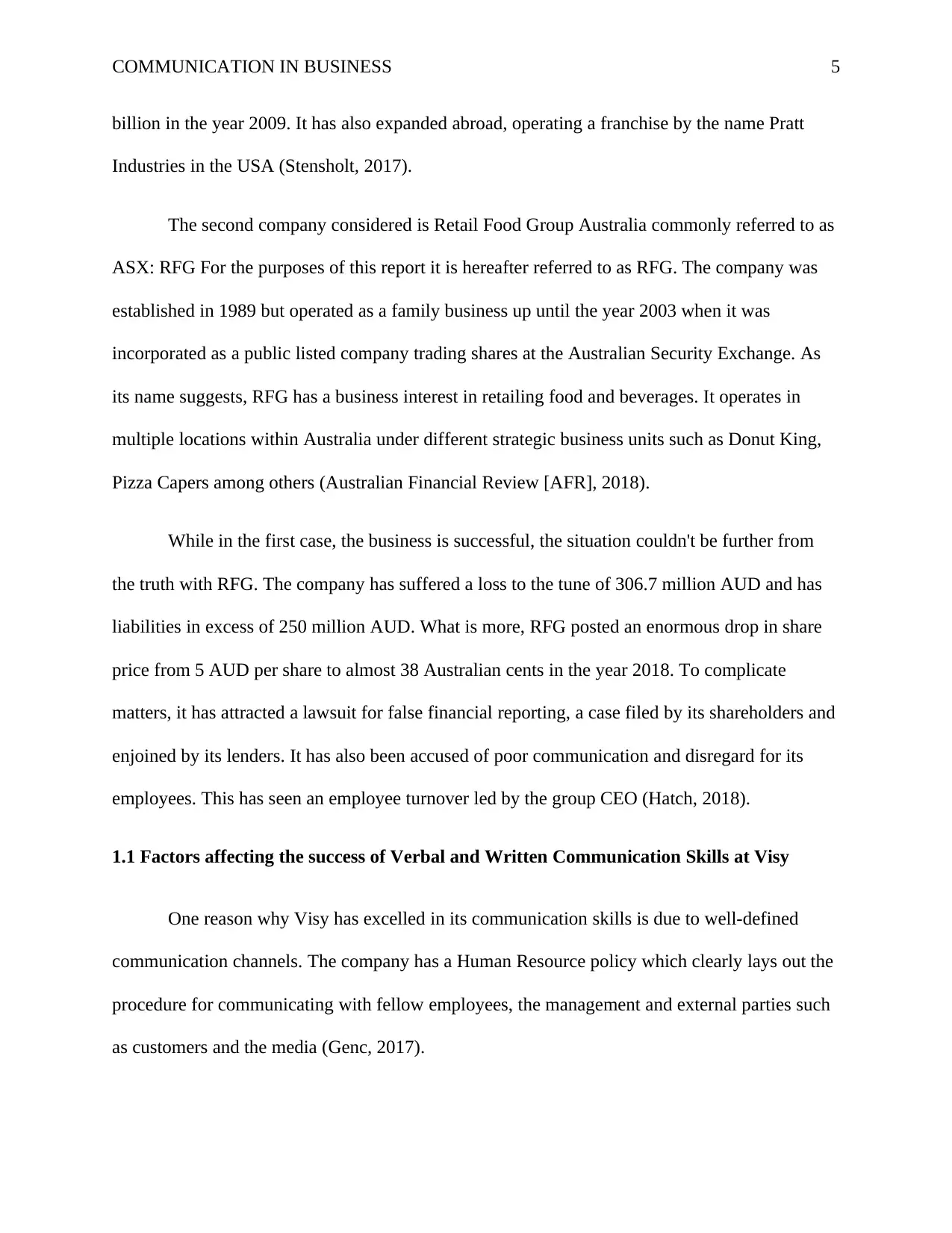
COMMUNICATION IN BUSINESS 5
billion in the year 2009. It has also expanded abroad, operating a franchise by the name Pratt
Industries in the USA (Stensholt, 2017).
The second company considered is Retail Food Group Australia commonly referred to as
ASX: RFG For the purposes of this report it is hereafter referred to as RFG. The company was
established in 1989 but operated as a family business up until the year 2003 when it was
incorporated as a public listed company trading shares at the Australian Security Exchange. As
its name suggests, RFG has a business interest in retailing food and beverages. It operates in
multiple locations within Australia under different strategic business units such as Donut King,
Pizza Capers among others (Australian Financial Review [AFR], 2018).
While in the first case, the business is successful, the situation couldn't be further from
the truth with RFG. The company has suffered a loss to the tune of 306.7 million AUD and has
liabilities in excess of 250 million AUD. What is more, RFG posted an enormous drop in share
price from 5 AUD per share to almost 38 Australian cents in the year 2018. To complicate
matters, it has attracted a lawsuit for false financial reporting, a case filed by its shareholders and
enjoined by its lenders. It has also been accused of poor communication and disregard for its
employees. This has seen an employee turnover led by the group CEO (Hatch, 2018).
1.1 Factors affecting the success of Verbal and Written Communication Skills at Visy
One reason why Visy has excelled in its communication skills is due to well-defined
communication channels. The company has a Human Resource policy which clearly lays out the
procedure for communicating with fellow employees, the management and external parties such
as customers and the media (Genc, 2017).
billion in the year 2009. It has also expanded abroad, operating a franchise by the name Pratt
Industries in the USA (Stensholt, 2017).
The second company considered is Retail Food Group Australia commonly referred to as
ASX: RFG For the purposes of this report it is hereafter referred to as RFG. The company was
established in 1989 but operated as a family business up until the year 2003 when it was
incorporated as a public listed company trading shares at the Australian Security Exchange. As
its name suggests, RFG has a business interest in retailing food and beverages. It operates in
multiple locations within Australia under different strategic business units such as Donut King,
Pizza Capers among others (Australian Financial Review [AFR], 2018).
While in the first case, the business is successful, the situation couldn't be further from
the truth with RFG. The company has suffered a loss to the tune of 306.7 million AUD and has
liabilities in excess of 250 million AUD. What is more, RFG posted an enormous drop in share
price from 5 AUD per share to almost 38 Australian cents in the year 2018. To complicate
matters, it has attracted a lawsuit for false financial reporting, a case filed by its shareholders and
enjoined by its lenders. It has also been accused of poor communication and disregard for its
employees. This has seen an employee turnover led by the group CEO (Hatch, 2018).
1.1 Factors affecting the success of Verbal and Written Communication Skills at Visy
One reason why Visy has excelled in its communication skills is due to well-defined
communication channels. The company has a Human Resource policy which clearly lays out the
procedure for communicating with fellow employees, the management and external parties such
as customers and the media (Genc, 2017).
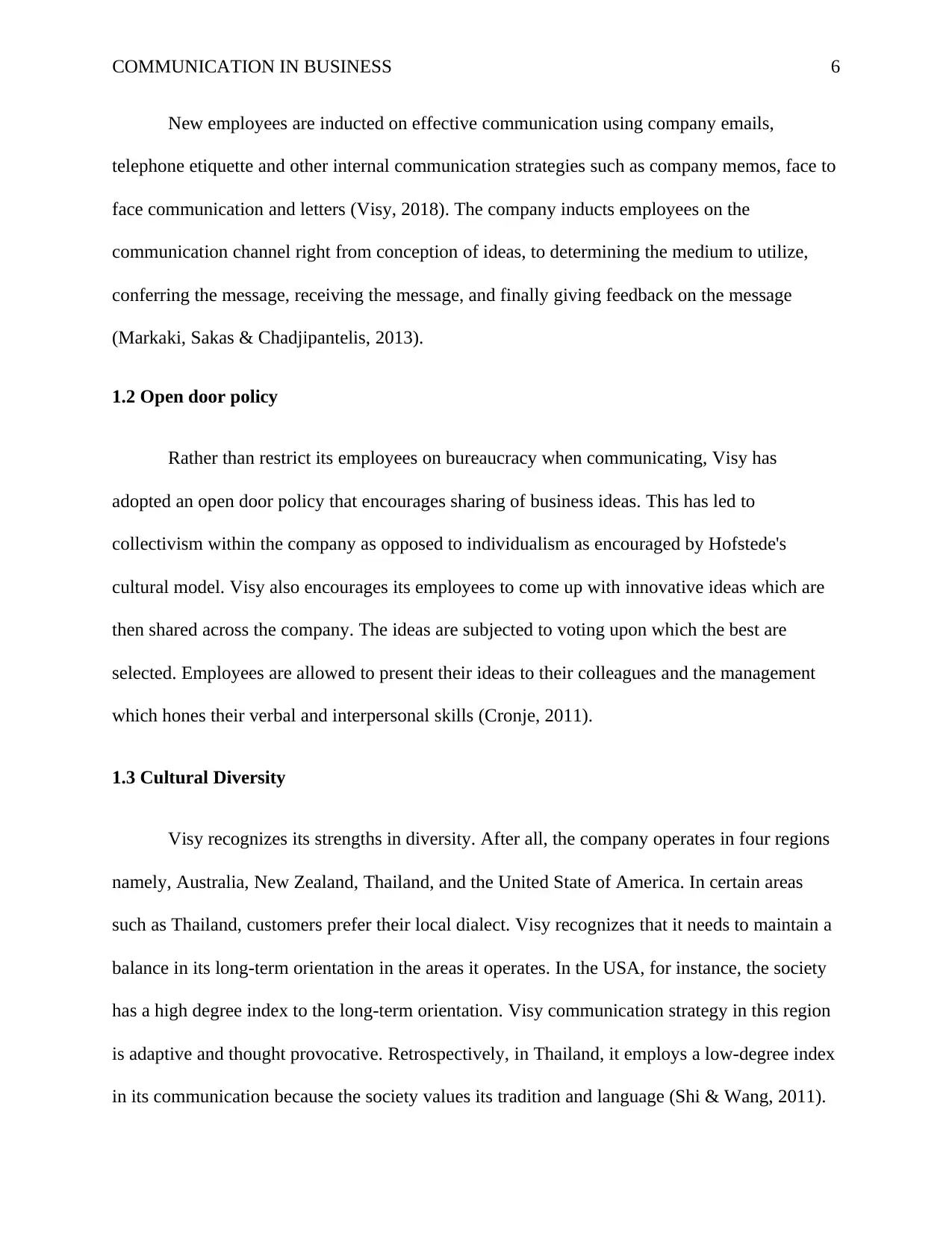
COMMUNICATION IN BUSINESS 6
New employees are inducted on effective communication using company emails,
telephone etiquette and other internal communication strategies such as company memos, face to
face communication and letters (Visy, 2018). The company inducts employees on the
communication channel right from conception of ideas, to determining the medium to utilize,
conferring the message, receiving the message, and finally giving feedback on the message
(Markaki, Sakas & Chadjipantelis, 2013).
1.2 Open door policy
Rather than restrict its employees on bureaucracy when communicating, Visy has
adopted an open door policy that encourages sharing of business ideas. This has led to
collectivism within the company as opposed to individualism as encouraged by Hofstede's
cultural model. Visy also encourages its employees to come up with innovative ideas which are
then shared across the company. The ideas are subjected to voting upon which the best are
selected. Employees are allowed to present their ideas to their colleagues and the management
which hones their verbal and interpersonal skills (Cronje, 2011).
1.3 Cultural Diversity
Visy recognizes its strengths in diversity. After all, the company operates in four regions
namely, Australia, New Zealand, Thailand, and the United State of America. In certain areas
such as Thailand, customers prefer their local dialect. Visy recognizes that it needs to maintain a
balance in its long-term orientation in the areas it operates. In the USA, for instance, the society
has a high degree index to the long-term orientation. Visy communication strategy in this region
is adaptive and thought provocative. Retrospectively, in Thailand, it employs a low-degree index
in its communication because the society values its tradition and language (Shi & Wang, 2011).
New employees are inducted on effective communication using company emails,
telephone etiquette and other internal communication strategies such as company memos, face to
face communication and letters (Visy, 2018). The company inducts employees on the
communication channel right from conception of ideas, to determining the medium to utilize,
conferring the message, receiving the message, and finally giving feedback on the message
(Markaki, Sakas & Chadjipantelis, 2013).
1.2 Open door policy
Rather than restrict its employees on bureaucracy when communicating, Visy has
adopted an open door policy that encourages sharing of business ideas. This has led to
collectivism within the company as opposed to individualism as encouraged by Hofstede's
cultural model. Visy also encourages its employees to come up with innovative ideas which are
then shared across the company. The ideas are subjected to voting upon which the best are
selected. Employees are allowed to present their ideas to their colleagues and the management
which hones their verbal and interpersonal skills (Cronje, 2011).
1.3 Cultural Diversity
Visy recognizes its strengths in diversity. After all, the company operates in four regions
namely, Australia, New Zealand, Thailand, and the United State of America. In certain areas
such as Thailand, customers prefer their local dialect. Visy recognizes that it needs to maintain a
balance in its long-term orientation in the areas it operates. In the USA, for instance, the society
has a high degree index to the long-term orientation. Visy communication strategy in this region
is adaptive and thought provocative. Retrospectively, in Thailand, it employs a low-degree index
in its communication because the society values its tradition and language (Shi & Wang, 2011).
⊘ This is a preview!⊘
Do you want full access?
Subscribe today to unlock all pages.

Trusted by 1+ million students worldwide
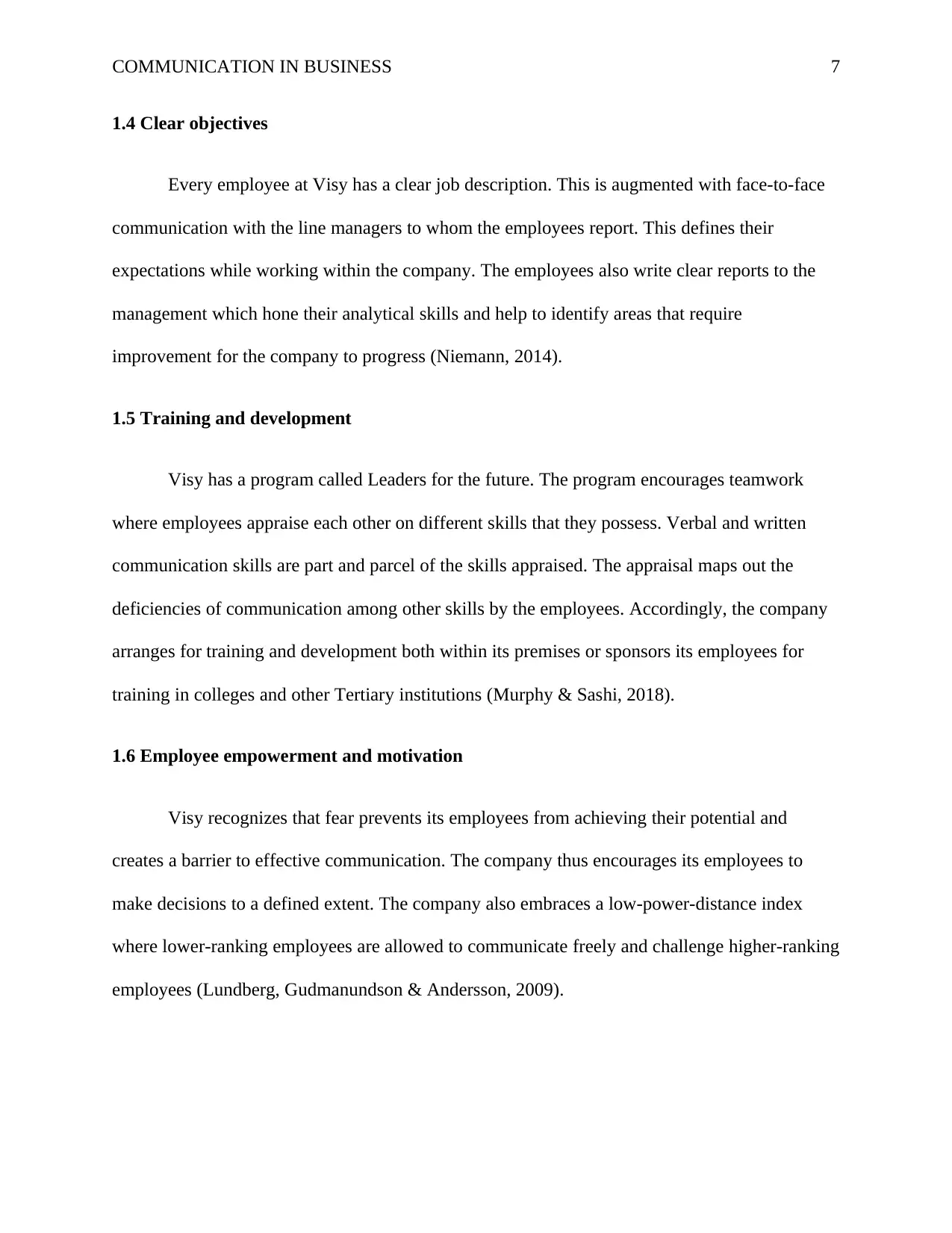
COMMUNICATION IN BUSINESS 7
1.4 Clear objectives
Every employee at Visy has a clear job description. This is augmented with face-to-face
communication with the line managers to whom the employees report. This defines their
expectations while working within the company. The employees also write clear reports to the
management which hone their analytical skills and help to identify areas that require
improvement for the company to progress (Niemann, 2014).
1.5 Training and development
Visy has a program called Leaders for the future. The program encourages teamwork
where employees appraise each other on different skills that they possess. Verbal and written
communication skills are part and parcel of the skills appraised. The appraisal maps out the
deficiencies of communication among other skills by the employees. Accordingly, the company
arranges for training and development both within its premises or sponsors its employees for
training in colleges and other Tertiary institutions (Murphy & Sashi, 2018).
1.6 Employee empowerment and motivation
Visy recognizes that fear prevents its employees from achieving their potential and
creates a barrier to effective communication. The company thus encourages its employees to
make decisions to a defined extent. The company also embraces a low-power-distance index
where lower-ranking employees are allowed to communicate freely and challenge higher-ranking
employees (Lundberg, Gudmanundson & Andersson, 2009).
1.4 Clear objectives
Every employee at Visy has a clear job description. This is augmented with face-to-face
communication with the line managers to whom the employees report. This defines their
expectations while working within the company. The employees also write clear reports to the
management which hone their analytical skills and help to identify areas that require
improvement for the company to progress (Niemann, 2014).
1.5 Training and development
Visy has a program called Leaders for the future. The program encourages teamwork
where employees appraise each other on different skills that they possess. Verbal and written
communication skills are part and parcel of the skills appraised. The appraisal maps out the
deficiencies of communication among other skills by the employees. Accordingly, the company
arranges for training and development both within its premises or sponsors its employees for
training in colleges and other Tertiary institutions (Murphy & Sashi, 2018).
1.6 Employee empowerment and motivation
Visy recognizes that fear prevents its employees from achieving their potential and
creates a barrier to effective communication. The company thus encourages its employees to
make decisions to a defined extent. The company also embraces a low-power-distance index
where lower-ranking employees are allowed to communicate freely and challenge higher-ranking
employees (Lundberg, Gudmanundson & Andersson, 2009).
Paraphrase This Document
Need a fresh take? Get an instant paraphrase of this document with our AI Paraphraser
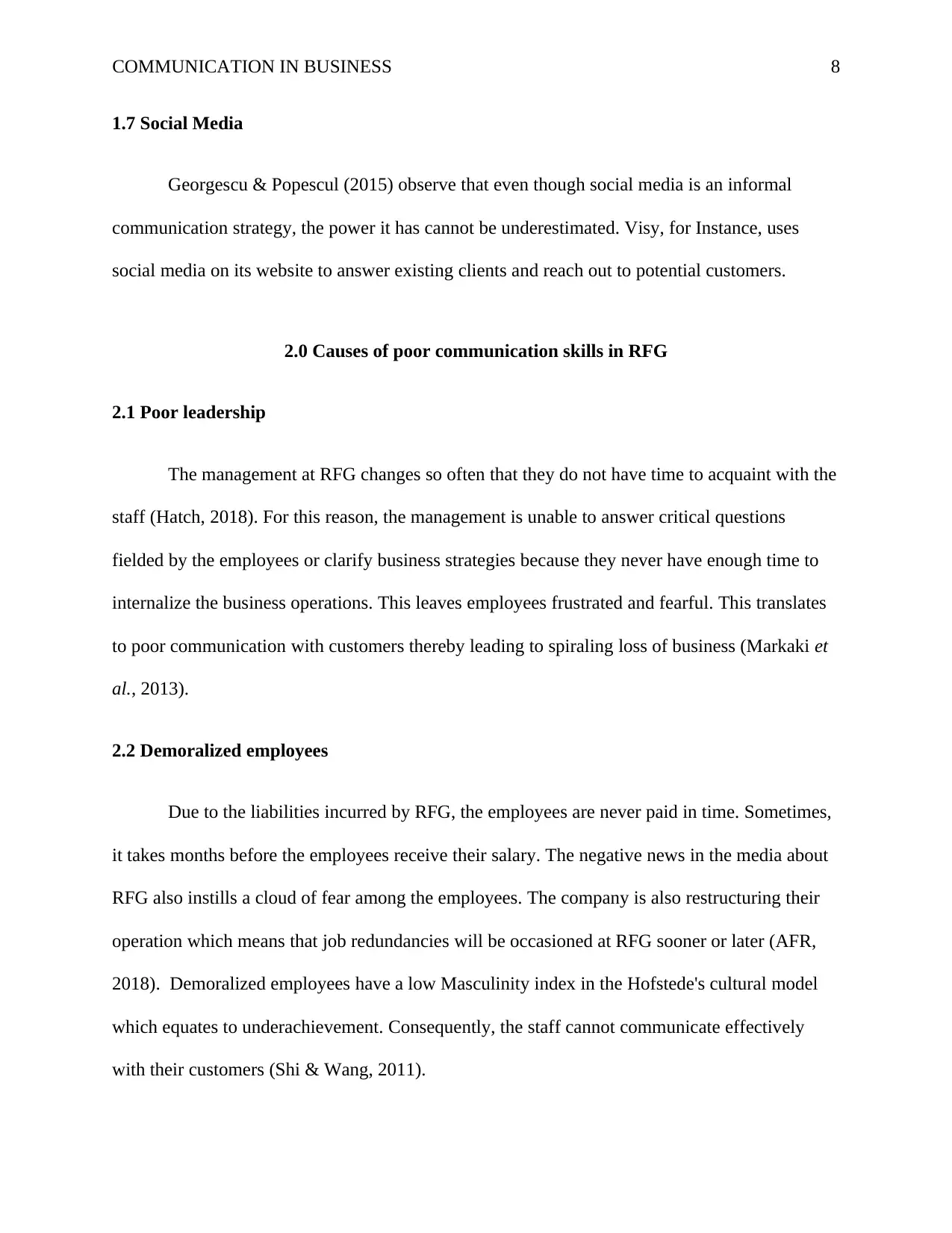
COMMUNICATION IN BUSINESS 8
1.7 Social Media
Georgescu & Popescul (2015) observe that even though social media is an informal
communication strategy, the power it has cannot be underestimated. Visy, for Instance, uses
social media on its website to answer existing clients and reach out to potential customers.
2.0 Causes of poor communication skills in RFG
2.1 Poor leadership
The management at RFG changes so often that they do not have time to acquaint with the
staff (Hatch, 2018). For this reason, the management is unable to answer critical questions
fielded by the employees or clarify business strategies because they never have enough time to
internalize the business operations. This leaves employees frustrated and fearful. This translates
to poor communication with customers thereby leading to spiraling loss of business (Markaki et
al., 2013).
2.2 Demoralized employees
Due to the liabilities incurred by RFG, the employees are never paid in time. Sometimes,
it takes months before the employees receive their salary. The negative news in the media about
RFG also instills a cloud of fear among the employees. The company is also restructuring their
operation which means that job redundancies will be occasioned at RFG sooner or later (AFR,
2018). Demoralized employees have a low Masculinity index in the Hofstede's cultural model
which equates to underachievement. Consequently, the staff cannot communicate effectively
with their customers (Shi & Wang, 2011).
1.7 Social Media
Georgescu & Popescul (2015) observe that even though social media is an informal
communication strategy, the power it has cannot be underestimated. Visy, for Instance, uses
social media on its website to answer existing clients and reach out to potential customers.
2.0 Causes of poor communication skills in RFG
2.1 Poor leadership
The management at RFG changes so often that they do not have time to acquaint with the
staff (Hatch, 2018). For this reason, the management is unable to answer critical questions
fielded by the employees or clarify business strategies because they never have enough time to
internalize the business operations. This leaves employees frustrated and fearful. This translates
to poor communication with customers thereby leading to spiraling loss of business (Markaki et
al., 2013).
2.2 Demoralized employees
Due to the liabilities incurred by RFG, the employees are never paid in time. Sometimes,
it takes months before the employees receive their salary. The negative news in the media about
RFG also instills a cloud of fear among the employees. The company is also restructuring their
operation which means that job redundancies will be occasioned at RFG sooner or later (AFR,
2018). Demoralized employees have a low Masculinity index in the Hofstede's cultural model
which equates to underachievement. Consequently, the staff cannot communicate effectively
with their customers (Shi & Wang, 2011).
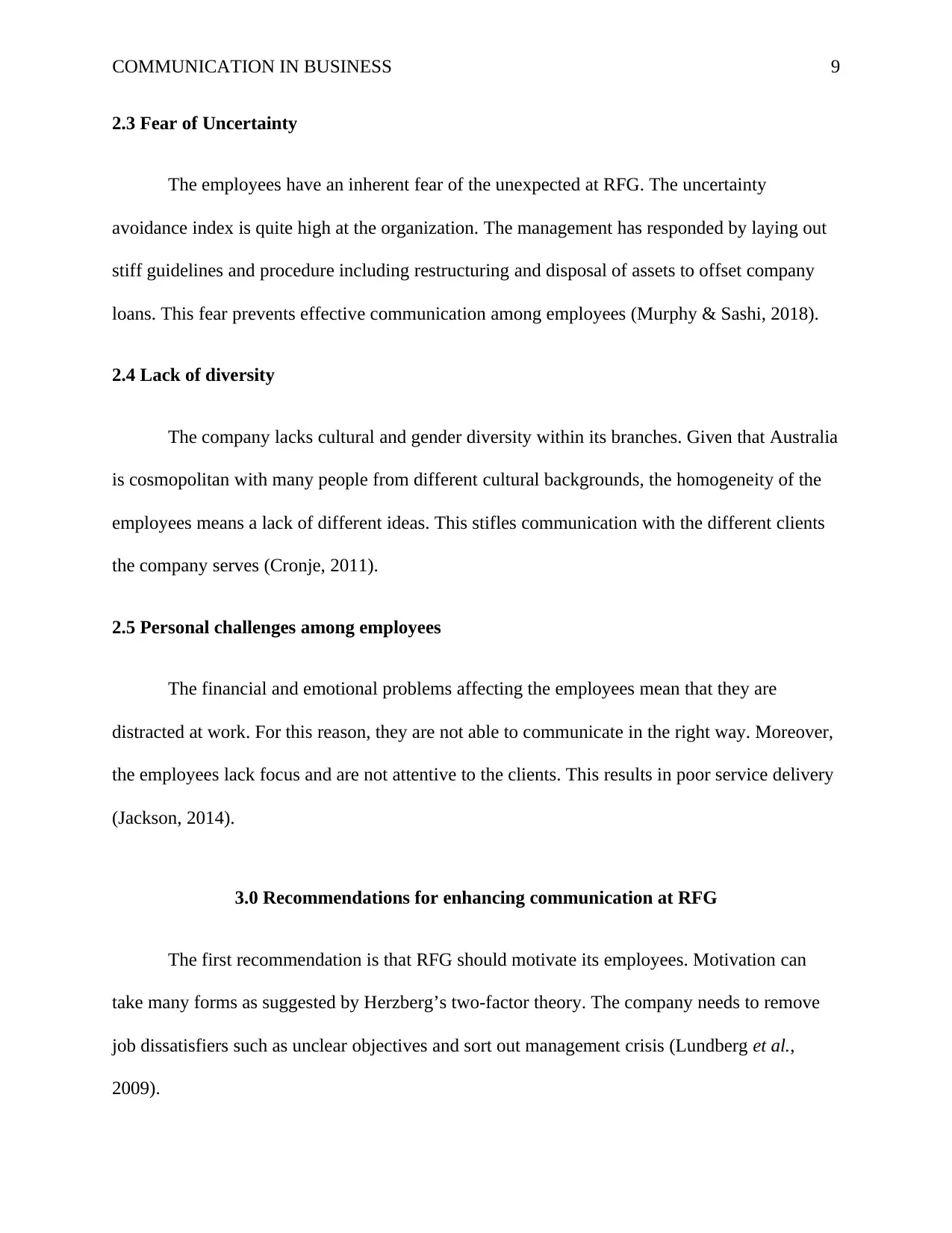
COMMUNICATION IN BUSINESS 9
2.3 Fear of Uncertainty
The employees have an inherent fear of the unexpected at RFG. The uncertainty
avoidance index is quite high at the organization. The management has responded by laying out
stiff guidelines and procedure including restructuring and disposal of assets to offset company
loans. This fear prevents effective communication among employees (Murphy & Sashi, 2018).
2.4 Lack of diversity
The company lacks cultural and gender diversity within its branches. Given that Australia
is cosmopolitan with many people from different cultural backgrounds, the homogeneity of the
employees means a lack of different ideas. This stifles communication with the different clients
the company serves (Cronje, 2011).
2.5 Personal challenges among employees
The financial and emotional problems affecting the employees mean that they are
distracted at work. For this reason, they are not able to communicate in the right way. Moreover,
the employees lack focus and are not attentive to the clients. This results in poor service delivery
(Jackson, 2014).
3.0 Recommendations for enhancing communication at RFG
The first recommendation is that RFG should motivate its employees. Motivation can
take many forms as suggested by Herzberg’s two-factor theory. The company needs to remove
job dissatisfiers such as unclear objectives and sort out management crisis (Lundberg et al.,
2009).
2.3 Fear of Uncertainty
The employees have an inherent fear of the unexpected at RFG. The uncertainty
avoidance index is quite high at the organization. The management has responded by laying out
stiff guidelines and procedure including restructuring and disposal of assets to offset company
loans. This fear prevents effective communication among employees (Murphy & Sashi, 2018).
2.4 Lack of diversity
The company lacks cultural and gender diversity within its branches. Given that Australia
is cosmopolitan with many people from different cultural backgrounds, the homogeneity of the
employees means a lack of different ideas. This stifles communication with the different clients
the company serves (Cronje, 2011).
2.5 Personal challenges among employees
The financial and emotional problems affecting the employees mean that they are
distracted at work. For this reason, they are not able to communicate in the right way. Moreover,
the employees lack focus and are not attentive to the clients. This results in poor service delivery
(Jackson, 2014).
3.0 Recommendations for enhancing communication at RFG
The first recommendation is that RFG should motivate its employees. Motivation can
take many forms as suggested by Herzberg’s two-factor theory. The company needs to remove
job dissatisfiers such as unclear objectives and sort out management crisis (Lundberg et al.,
2009).
⊘ This is a preview!⊘
Do you want full access?
Subscribe today to unlock all pages.

Trusted by 1+ million students worldwide
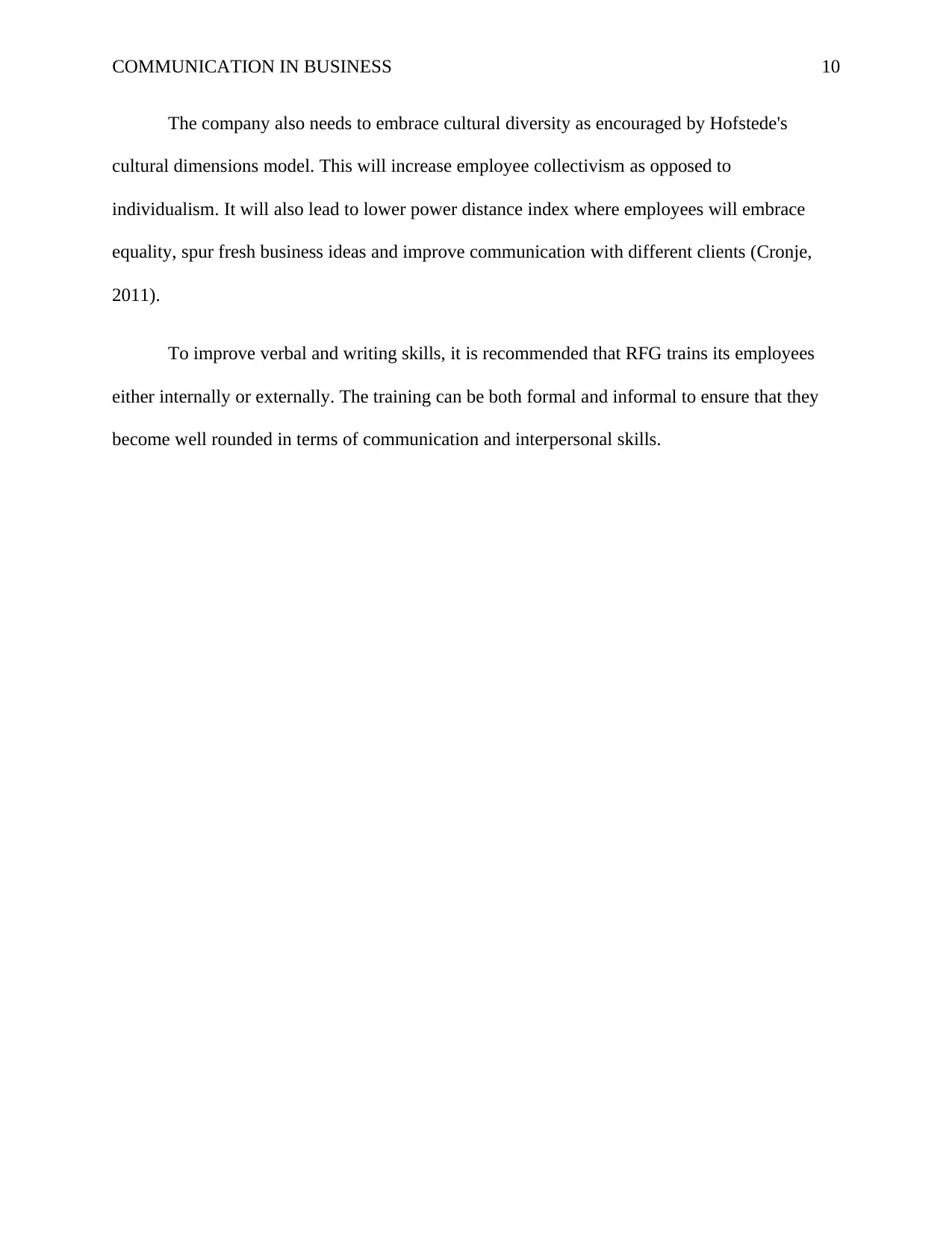
COMMUNICATION IN BUSINESS 10
The company also needs to embrace cultural diversity as encouraged by Hofstede's
cultural dimensions model. This will increase employee collectivism as opposed to
individualism. It will also lead to lower power distance index where employees will embrace
equality, spur fresh business ideas and improve communication with different clients (Cronje,
2011).
To improve verbal and writing skills, it is recommended that RFG trains its employees
either internally or externally. The training can be both formal and informal to ensure that they
become well rounded in terms of communication and interpersonal skills.
The company also needs to embrace cultural diversity as encouraged by Hofstede's
cultural dimensions model. This will increase employee collectivism as opposed to
individualism. It will also lead to lower power distance index where employees will embrace
equality, spur fresh business ideas and improve communication with different clients (Cronje,
2011).
To improve verbal and writing skills, it is recommended that RFG trains its employees
either internally or externally. The training can be both formal and informal to ensure that they
become well rounded in terms of communication and interpersonal skills.
Paraphrase This Document
Need a fresh take? Get an instant paraphrase of this document with our AI Paraphraser
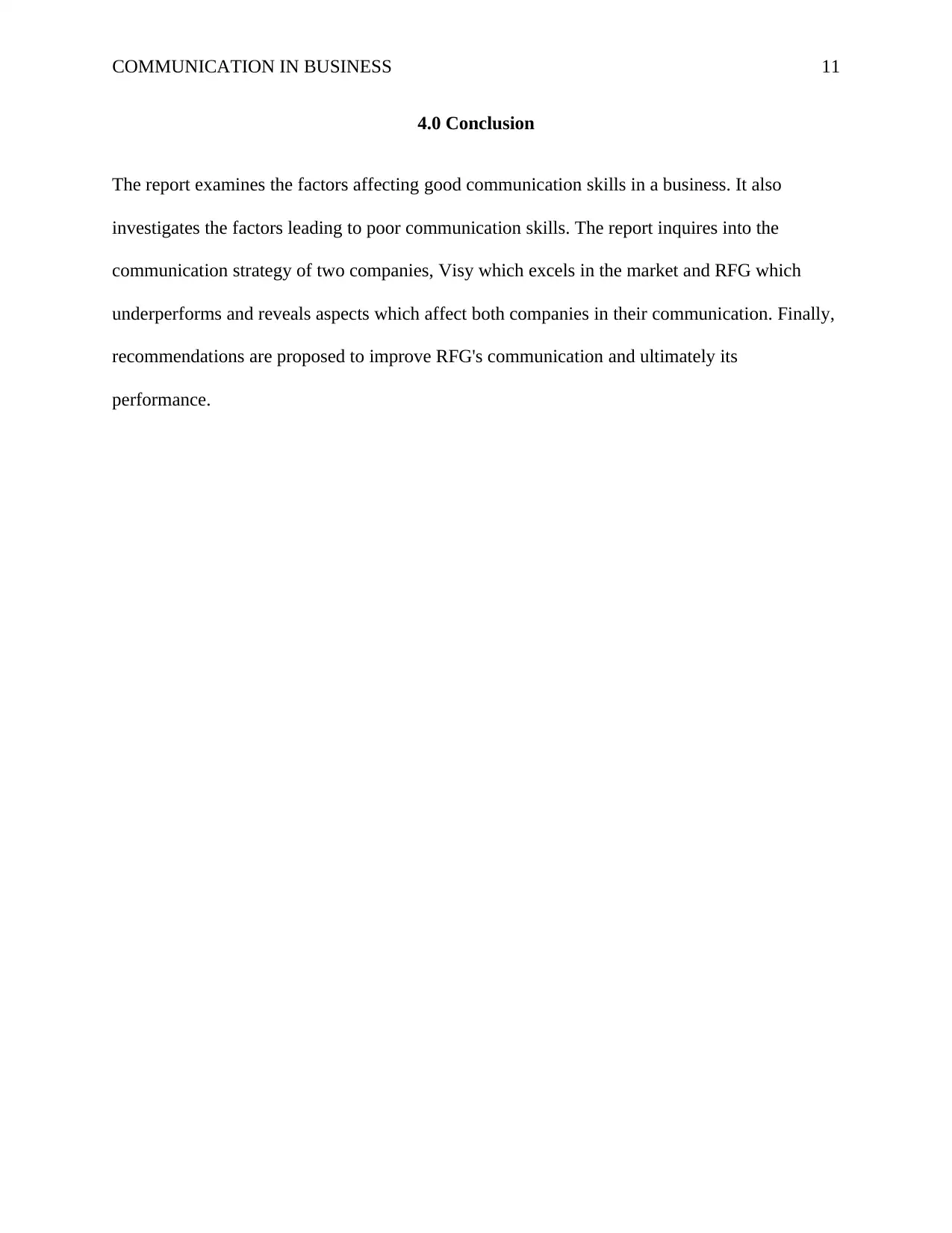
COMMUNICATION IN BUSINESS 11
4.0 Conclusion
The report examines the factors affecting good communication skills in a business. It also
investigates the factors leading to poor communication skills. The report inquires into the
communication strategy of two companies, Visy which excels in the market and RFG which
underperforms and reveals aspects which affect both companies in their communication. Finally,
recommendations are proposed to improve RFG's communication and ultimately its
performance.
4.0 Conclusion
The report examines the factors affecting good communication skills in a business. It also
investigates the factors leading to poor communication skills. The report inquires into the
communication strategy of two companies, Visy which excels in the market and RFG which
underperforms and reveals aspects which affect both companies in their communication. Finally,
recommendations are proposed to improve RFG's communication and ultimately its
performance.
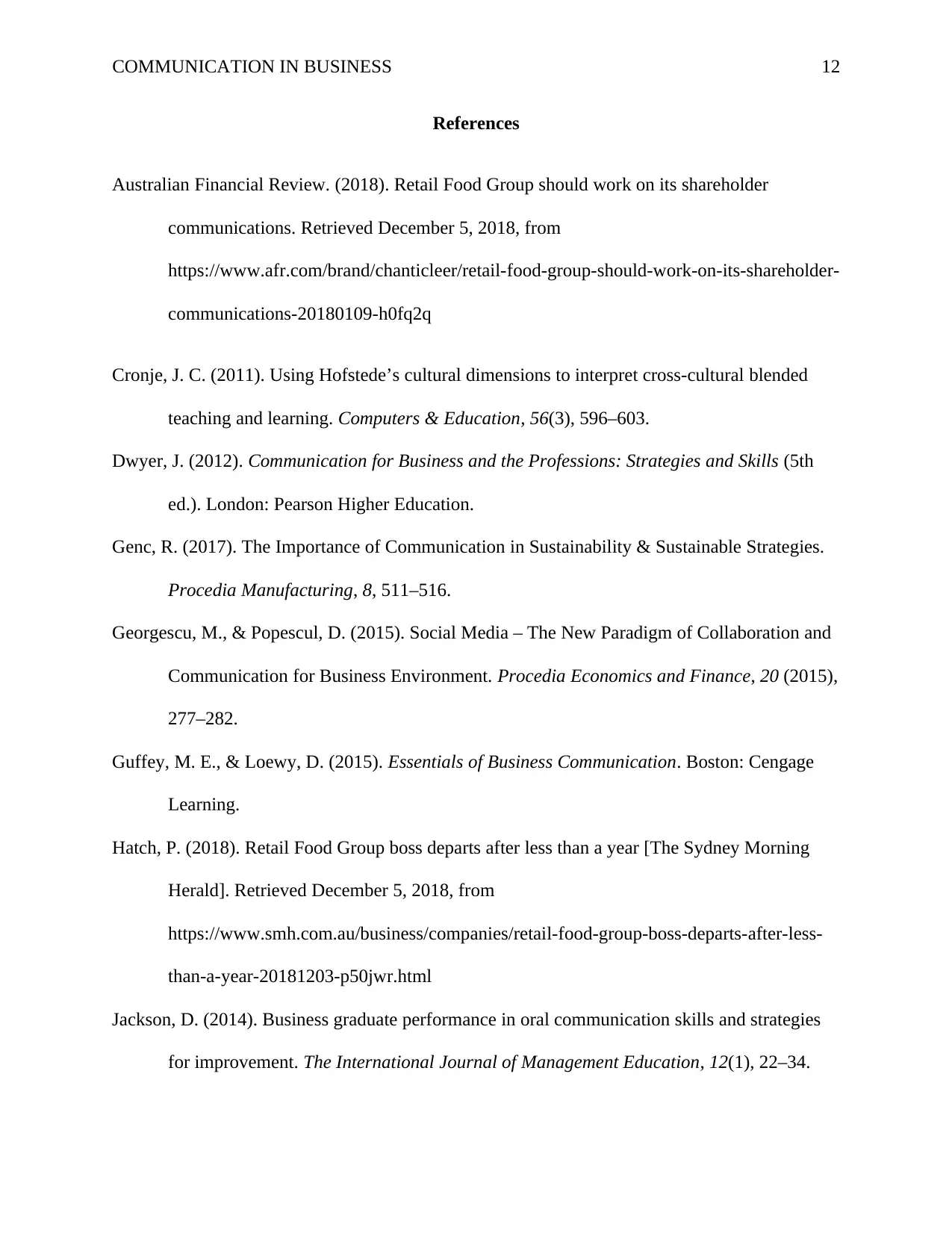
COMMUNICATION IN BUSINESS 12
References
Australian Financial Review. (2018). Retail Food Group should work on its shareholder
communications. Retrieved December 5, 2018, from
https://www.afr.com/brand/chanticleer/retail-food-group-should-work-on-its-shareholder-
communications-20180109-h0fq2q
Cronje, J. C. (2011). Using Hofstede’s cultural dimensions to interpret cross-cultural blended
teaching and learning. Computers & Education, 56(3), 596–603.
Dwyer, J. (2012). Communication for Business and the Professions: Strategies and Skills (5th
ed.). London: Pearson Higher Education.
Genc, R. (2017). The Importance of Communication in Sustainability & Sustainable Strategies.
Procedia Manufacturing, 8, 511–516.
Georgescu, M., & Popescul, D. (2015). Social Media – The New Paradigm of Collaboration and
Communication for Business Environment. Procedia Economics and Finance, 20 (2015),
277–282.
Guffey, M. E., & Loewy, D. (2015). Essentials of Business Communication. Boston: Cengage
Learning.
Hatch, P. (2018). Retail Food Group boss departs after less than a year [The Sydney Morning
Herald]. Retrieved December 5, 2018, from
https://www.smh.com.au/business/companies/retail-food-group-boss-departs-after-less-
than-a-year-20181203-p50jwr.html
Jackson, D. (2014). Business graduate performance in oral communication skills and strategies
for improvement. The International Journal of Management Education, 12(1), 22–34.
References
Australian Financial Review. (2018). Retail Food Group should work on its shareholder
communications. Retrieved December 5, 2018, from
https://www.afr.com/brand/chanticleer/retail-food-group-should-work-on-its-shareholder-
communications-20180109-h0fq2q
Cronje, J. C. (2011). Using Hofstede’s cultural dimensions to interpret cross-cultural blended
teaching and learning. Computers & Education, 56(3), 596–603.
Dwyer, J. (2012). Communication for Business and the Professions: Strategies and Skills (5th
ed.). London: Pearson Higher Education.
Genc, R. (2017). The Importance of Communication in Sustainability & Sustainable Strategies.
Procedia Manufacturing, 8, 511–516.
Georgescu, M., & Popescul, D. (2015). Social Media – The New Paradigm of Collaboration and
Communication for Business Environment. Procedia Economics and Finance, 20 (2015),
277–282.
Guffey, M. E., & Loewy, D. (2015). Essentials of Business Communication. Boston: Cengage
Learning.
Hatch, P. (2018). Retail Food Group boss departs after less than a year [The Sydney Morning
Herald]. Retrieved December 5, 2018, from
https://www.smh.com.au/business/companies/retail-food-group-boss-departs-after-less-
than-a-year-20181203-p50jwr.html
Jackson, D. (2014). Business graduate performance in oral communication skills and strategies
for improvement. The International Journal of Management Education, 12(1), 22–34.
⊘ This is a preview!⊘
Do you want full access?
Subscribe today to unlock all pages.

Trusted by 1+ million students worldwide
1 out of 13
Related Documents
Your All-in-One AI-Powered Toolkit for Academic Success.
+13062052269
info@desklib.com
Available 24*7 on WhatsApp / Email
![[object Object]](/_next/static/media/star-bottom.7253800d.svg)
Unlock your academic potential
Copyright © 2020–2025 A2Z Services. All Rights Reserved. Developed and managed by ZUCOL.





